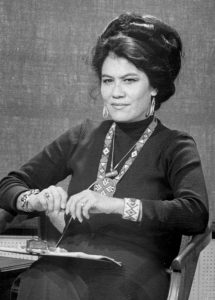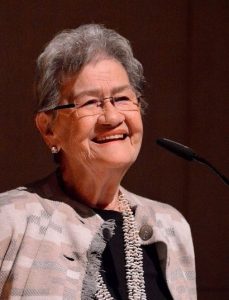More than 3,000 participants attend Minneapolis event

The late Harriett Skye on the set of Indian Country Today, a TV talk show she hosted from 1973-1984. Skye interviewed local, regional and national leaders on contemporary news and events making her one of the few talk show hosts in Native media history. PHOTO COURTESY DENNIS NEUMANN
By Jodi Rave
Buffalo’s Fire
Some textbook definitions send me into The Thinker pose, especially descriptions like “trailblazer,” a word used to describe the late multimedia journalist Harriett Skye. A trailblazer can be an “innovator,” a “pioneer” or “a person who makes a new track through wild country.”
I wouldn’t use the word pioneer to describe Skye, a beautiful Lakota woman from the Standing Rock Reservation who recently died at age 86. She was definitely an innovator who made tracks through the wild country of North Dakota, wild in the sense that state legislators tried to pass bills in 2017, making it legal to run over protesters if they were on the highway.

Harriett Skye on the set of Indian Country Today.
Skye — a multimedia journalist who practiced print, radio, TV and film — died in California on January 20. I grew up watching her host a TV program called “Indian Country Today” from 1973 to 1984. The name was later used in 1981 for what would become the country’s largest independent Native newspaper, Indian Country Today, which was later sold to the Oneida Tribe. It then took the name, Indian Country Today Media Network, again, the largest Native media news outlet.
None of these media ventures exist anymore — the ICTMN rests in silence after closing the doors in fall 2017 and being gifted to the National Congress of American Indians.
Skye emerged as one of the first American Indian TV show hosts through a provision of the Federal Communication Commission’s Ascertainment program, established in 1971. The program allowed for media programming representation of minority viewpoints. The FCC deregulated the airwaves in 1981, resulting in less coverage of minority issues.
Skye started hosting “Indian Country Today” in 1973. For more than a decade, she filmed some 250 episodes, most of which were recorded on 2-inch, reel-to-reel videotape. Producers used the same tape for each show, so only a few of the final episodes survived to be archived at the North Dakota State Historical Society.
My family moved to Bismarck in 1977. As a transfer student, the junior high staff teamed me up with Jessica Skye Paul, Harriett’s daughter, to help me get acquainted with my new school. Skye Paul, who remains my friend, and I agree we never realized during those youthful years that “Indian Country Today” was a rarity.
Instead, Harriett Skye made it seem natural for an Indian woman to report and broadcast the news to a regional audience in the Northern Great Plains. She was on the air twice a month for about 11 years and interviewed regional and national leaders in the Meyer Broadcasting studio in Bismarck, N.D.
Skye Paul and I became very good friends from junior high through high school. Her mother wasn’t just someone on TV. She was a role model who had a great influence on my life. I joined the news staff at the Bismarck Hi-Herald, the high school newspaper. My first published piece was a column about American Indians. I also became a reporter in the North Dakota Army National Guard
After earning a journalism degree from the University of Colorado, I looked for jobs that would let me report on American Indians. They didn’t exist. In 1998, Lee Enterprises created a national reporting position, and I was hired to report on American Indians.

Harriet Skye died Jan. 20, 2018. She was 86 years old. PHOTO COURTESY JESSICA SKYE PAUL
Fast forward to 2018, and Skye’s death gives reason to pause because American Indians on TV are still pretty nonexistent. I can’t think of a single Native person on TV today who hosts a talk show about contemporary Native news.
The Communications Act of 1934 gave the FCC power to regulate the airwaves in the public interest, but the commission has been less inclined – as time goes on — to bolster the presence minority people. FNX, however, is making inroads with Native-driven programming in California and New Mexico.
Skye Paul recently told me how her mother watched the Standing Rock protests on social media and was fascinated by the water protector’s role in live streaming and photographing events in real time. Like many around the world, I, too, watched Standing Rock unfold on social media.
A national Native broadcast network does not exist here in the United States. The national networks – who arrived late to Standing Rock — captured images of Indians in tipis and riding horses. It’s the type of Wild West, historical imagery by which mainstream American can sink its teeth into.
I wish we had a national Native broadcasting network — similar to the Aboriginal Public Television Network in Canada — that could have reported on Standing Rock. I also wish that network was staffed with dozens of Harriett Skyes.
We all have work to carry on.
———————————————————————————————-
Jodi Rave Spotted Bear, executive director of the Indigenous Media Freedom Alliance, has received column writing awards and honors from Columbia University School of Journalism, the Native American Journalists Association, the Society of Professional Journalists-Pacific Northwest and the Montana Newspaper Association. She earned a journalism degree from the University of Colorado-Boulder.
Jodi Rave Spotted Bear (Mandan, Hidatsa and Arikara Nation)
Founder & Editor in Chief
Location: Twin Buttes, North Dakota
Spoken Languages: English
Topic Expertise: Federal trust relationship with American Indians; Indigenous issues ranging from spirituality and environment to education and land rights
See the journalist page© Buffalo's Fire. All rights reserved.
This article is not included in our Story Share & Care selection.The content may only be reproduced with permission from the Indigenous Media Freedom Alliance. Please see our content sharing guidelines.
This article was produced for ProPublica’s Local Reporting Network in partnership with Honolulu Civil Beat
ProPublica
Inspired by her grandparents, Tonah Fishinghawk-Chavez proves that caring for the community is an action, not just a word
Police and family looking for Angel Mendez and Zayne LaFountain







